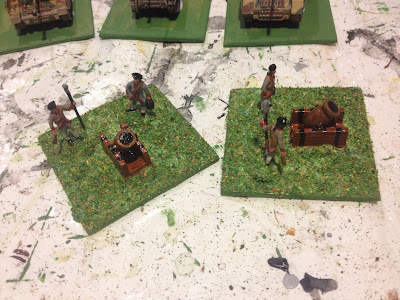Having decided to play a few siege games and having built much of the necessary terrain: a fortress, gabions and trenches for the besiegers. (An opportunity to take some photos for this post.) The next step was to start thinking about some rules, which will be in a similar vein to One Hour Wargames rules.
 |
| Some reading to help with ideas and they have some rules in the appendix. |
To help get some ideas of how formal sieges were conducted around the 1700-1750 period. I re-read a few chapters from Fire and Stone by Christopher Duffy to remind myself about the stages sieges typically went through.
Supplies are important in a siege for both sides, besieger and fortress garrison, but I am aiming to minimise paperwork in the rules. Players will each have one pool of supply points which represent a range of resources, such as: ammunition, food, and money. In the case of the besiger these are expended during the formal siege stage to: dig parallels, extend zig-zag sap trenches, maintaining units in the field, conduct bombardments, mine, and repair damaged artillery. Whilst the garrison player will use their supplies to: repair defences, keep units on the defences, counter-mine, and counter-battery fire. Careful management of these resources by players will be key to their success. Historically, there were many discussions and theories put forward as to the best way to assault and defend a fortress, and a balanced approach across the various stages of a siege seemed common.
The game will have three stages:
- Investment
- Counter-vallation
- Formal Siege
- Terms of surrender
 |
| Initial entreatments as besiegers begin the counter-vallation and seal off the fortress from the outside world |
1) Investment
The first phase of the siege game is investment. Where leading elements of the besieging force converge on the fortress to mop up any stragglers and supplies trying to reach the fortress. A game will be played with small and mainly mobile forces. If the defender wins the game additional supply points are added to the defenders pool. If the attacker wins the defender is denied and the supplies are redirected to the besiegers supply points.
2) Counter-vallation
The besieging player builds entrenched positions out of range of the guns to protect from sorties and to begin the process of isolating the fortress from the outside world. The defenders may still be in communication with the commander of a relief force. Who may try breaking through with a hand-picked force. To represent this stage a small battle will be fought. If the relief force breaks through the fortress gains additional supply points are added to the defenders pool.
 |
| Second parallel starts to take shape. |
 |
| A sortie strikes out from the fortress in an attempt to disrupt the siege works and spike artillery. |
3) Formal Siege
Each turn in the siege has two phases:
- An operational phase representing a day’s activities digging trenches and conducting bombardments
- A tactical phase representing a bust of activity in the siege such: as a sortie by the defenders to destroy the encroaching siege works or a surprise attack with scaling ladders.
Sieges were carefully planned and with often a mathematical and structured approach. As the siege turns progress the besieging play must first construct their 1st parallel of trenches. Following by the 2nd parallel of trenches from where most of the artillery bombardment tries to breakdown the fortress walls and make breaches. Then finally the 3rd parallel from which attacking units try and storm breaches.
 |
| From the 2nd parallel artillery pound the walls to create breaches. |
Bombardment of fortress walls can also include the use of mortars to launch bombs into the fortress upon the garrison to: deflate their moral and attempt to destroy their ammunition stocks. While the garrison artillery would attempt to delay the building of trenches and disrupt the attackers artillery galleries.
 |
| The 3rd parallel provides cover for troops and artillery as they try and clear the fortress galleries and defences. |
Other siege works can be undertaken such as mining the walls. These will be invisible on the tabletop and will consume the supply points until exploded, unless successfully countermined by the garrison.
During the formal siege phase each operational phase activity (bombardment, digging trenches, mining, etc) will consume supply points. So both sides will have to ration their use. If an attacker runs out of supply points they may find their parallel trenches and saps are short of the fortress walls and their troops will have little cover from which to storm the fortress. While for the defender not being able to repair breaches or artillery will hamper their defence and may force them to unfavourable terms of surrender.
 |
| A mine creates a breach |
 |
| A breach appears in the walls. |
4) Discuss terms of surrender
When the defenders supply points are reduced to zero the besieging side can offer negotiated terms by which the garrison will cede the fortress with honour. These terms can be offered a set number of times, and if refused they will have no option but to storm the fortress. Historically, once the fortress defences were no longer tenable discussing terms of surrender, often with some honour afforded to the garrison, avoided costing losses during the storming of a fortress.
Next steps...
While I get on writing the rules and playing some test games. I do still have a few remaining items to build including some mortars and a few Cheval de Frise (big spiking obstructions) to indicate where defenders have repaired defences.
 |
| cheval de frise |

















































